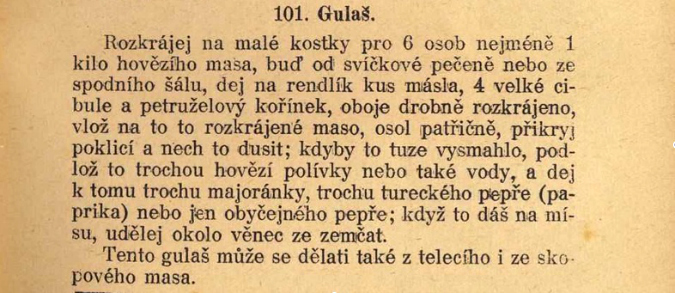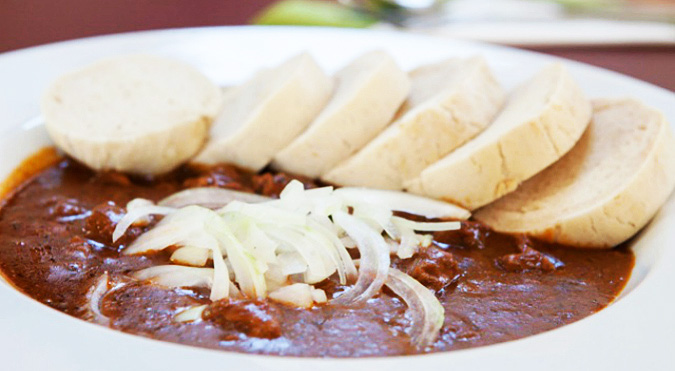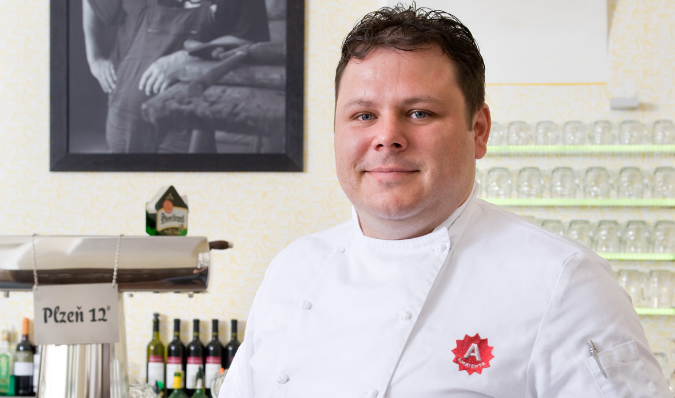Goulash has a special place in the hearts and minds of Czechs, despite not originating in the Czech lands. It arrived here largely due to a 1910 cookbook Household Cookery by Prague chef Magdalena Dobromila Rettigova, who presented the Hungarian recipe of goulash, while Hungary itself was first introduced to goulash by the invading Turkish army in 1526.
Since the early 20th century, the classic meat stew has become a staple of both home cooking and restaurant menus across the Czech Republic, a humble dish that while having almost infinite possibilities of spicing and ingredients comes down to a balance of quality meat and onion, and the right seasoning. Oh, and several hours of stewing on the stovetop. Most popular versions include the traditional beef, or pork (which can be a completely different goulash, Szeged, cooked with cream and cabbage in the mix), and deluxe, rustic versions featuring wild boar or venison. It’s also such a flexible dish that it can even be made in vegetarian and vegan versions.
We talked to local chefs about what goulash means to them and asked them to share their favorite goulash recipe. Here’s what they had to say.

Rettigova’s 1910 recipe for goulash
Jitka Plesz of Eat Art Gallery in Mikulov, South Moravia
The small, picturesque capital of the south Moravian wine country, Mikulov, has many attractions, not least of which is Eat Art Gallery, a humble restaurant and pension that serves up family recipes in the Plesz family’s living room, with mother and daughter bustling between kitchen and tables and using ingredients either picked from the back garden or sourced from nearby farms. The menu is rustic and, on a recent visit, featured a well-stewed beef goulash served with egg spaetzle and pickles on the side.
Jitka says her recipe more closely resembles Hungarian versions, thickened with extra juice. “In Czech cuisine, goulash is traditional and plays an important role in all of its forms: pork, beef, mutton, and even with potatoes and sausage sometimes, or combined with mushrooms, peppers and beans,” she says. “It’s also a favorite variation to make a goulash soup, where the meat is cut into small cubes or coarsely ground, and adding potatoes and marjoram. Goulash is popular because it can fill up the whole family for quite cheap, and it never disappoints.”
In this recipe, Jitka adds a bit of sweetness in the form of nutmeg and cinnamon, which gives an interesting balance to the stewed meat.
Jitka’s beef goulash with spaetzle
Serves 4 to 6 people
Ingredients
1 kg beef shin
500 g onion, finely sliced
20 g lard
4 tbsp sweet Hungarian paprika
4-6 cloves garlic, minced
1 tbsp cumin
Salt to taste
Broth
1 bottle Pilsner Urquell
4 slices mature rye bread, without crust, grated
Allspice, optional

Add potatoes to leftovers for a goulash soup
Preparation
After letting the meat rest to room temperature, remove the extra tissues and most of the fat from the cut, and slice into 3 centimeter cubes.
In a large, heated pot, dissolve the lard and add the onions with a bit of salt, then a bit of water. Add the meat, mix together and add cumin, two-thirds of the paprika and stir until the meat becomes a light pink.
Add enough broth or water until the meat is barely immersed. Cover, and simmer, stirring occasionally and basting with beer for approximately two hours.
When meat is soft, add a pinch of salt to taste. Thicken with crumbled rye bread, add the remainder of the beer and cook, stirring frequently, with the lid off. Add remaining spices, crushed garlic and the rest of the paprika.
Simmer for 5 minutes further, but be careful the meat does not start to tear apart.
Serve with homemade spaetzle and pickle slices.
Note: Best consumed within two days; reheat only individual portions and not the whole pot. It tastes even better when stewed in large quantities, as a pub would do, with at least 5 kilos of meat. It can then be frozen in portions or jarred.
Libor Baďura, from Lokál U Zavadilu in Prague 4-Kunratice
The Lokál chain of restaurants, part of the Ambiente group, has really taken off the past few years, a testament to people’s continuing love for well-made, time-tested Czech recipes. Lokál takes a Slow Food approach to the classics, and chef Libor Badura, from Lokál’s Kunratice locale, explains that his appreciation for goulash also was a slow-building passion. “I knew this recipe from my schooldays, but at the time I didn’t like it. It seemed all wrong to me to add pickled cucumber into a beef goulash.,” he says of the recipe he shares with Expats.cz. “I actually didn’t encounter this recipe again until I started working at Lokál on Dlouhá street [the chain’s first branch]. I found it interesting as this version used beef cheek, and that gave the goulash an entirely different flavor.”
“Goulash means something different for everyone,” he says. “For some Czechs, it means a taste of home, and for others, it means a holiday in Hungary.”

Libor Baďura, Lokal
Libor’s Znojmo goulash with beef cheek
Serves 5 people
Ingredients
500 g beef cheek, chopped into bitesize pieces
300 g onions, chopped finely
100 g garlic, crushed
90 g pickles, chopped
100 g lard, rendered
50 g smooth flour
3.5 liters beef broth
50 g sweet paprika
4 g whole cumin
1 g caraway seeds, crushed
13 g salt
2 g black pepper
1 g marjoram
1 small chilli pepper
Preparation
Heat a large pot with half of the lard. Add the onion and garlic, rubbed with the fresh chilli and the cumin, and fry until golden brown.
Add the beef cheeks, and continue to sauté until the meat begins to soften. Sprikle with the paprika, and toss with salt and pepper. Add the rest of the spices and 1 liter of the beef broth, and braise. Cover and stir occasionally, slowly adding more beef broth, to prevent the meat from burning.
When the meat is tender, remove from the pot. Add the remaining beef broth and the remaining lard and flour to create a roux; after thickening, add salt.
Strain the concentrate goulash sauce and add to the meat. Drop in the sliced pickles, lightly cooked, and it’s ready to serve.
Karel Chlumec, from LoVeg, in Prague 1-Malá Strana
A meatless version of goulash may sound anathema to some, but at LoVeg, a new vegetarian restaurant in Malá Strana, owner Karel Chlumec maintains that many of his customers are taken aback with surprise at how enjoyable a vegetarian version of the classic dish can be. “Nowadays, goulash means any kind of stewed meat made with a similar formula, and this includes vegan meat. At LoVeg, we used plant-based meat,” he says.
“What makes the finest goulash is finding that right moment to add the sweet paprika to the pot and burn it perfectly with caramelized onions and the meat,” he explains. “Our customers often don’t even recognize the difference between our vegan goulash and the traditional beef goulash. They love it because it is lighter than the red meat, and healthier, of course. And vegans love it especially when it comes with our homemade vegan dumplings, which are otherwise pretty impossible to find in Czech restaurants.”

LoVeg’s vegan goulash
Karel’s vegan goulash
Finely chop white onions, the same amount as the vegan meat (soya, seitan, tofu) that you want to include.
Heat up oil in a large pot and add the onions. When they start to turn brown, add chopped garlic and chilli peppers. Allow the onions to turn a darker brown.
Sprinkle with sweet paprika and allow the spices to blend through frying. If you want a thicker sauce, you can add some flour for a denser consistency.
For extra taste, you can add dark beer or red wine. Experiment!
Add some stock to the mixture to ensure the transition from frying to stewing. It’s possible to add tomato puree and dark soy sauce to give the goulash more strength and color.
Add bay leaves, pimento, black pepper and salt. Cook thoroughly; cooking time depends on the type of vegan meat used.
Marek Janouch, Lokál v Dlouhé & U bílé kuželky in Prague
Marek Janouch is another star chef of the Lokál chain, and he is enthusiastic about goulash in its many forms. “I chose a goulash made with pork knuckle and horseradish because it is unusual, and it’s a variation on the traditional beef goulash that everyone makes.” Making a good goulash requires a certain level of care and attention, he maintains. “Goulash needs perfect care, a sufficient basis and excellent-quality meat, such as beef shin, beef cheek, pork knuckle or pork shoulder. The meat should have the right marbled structure it needs to be slowly cooked without becoming tough.”
Marek says that despite its Hungarian origins, goulash is most decidedly a staple of Czech cooking. “Since it’s been prepared in Czech cuisine, it has become domesticated, and has been transformed into a traditional Czech dish. Each goulash that is cooked with love and quality ingredients is good, whether it is beef, pork or venison.”

Marek Janouch, Lokál
Marek’s pork goulash with fresh horseradish
Ingredients
1 pork shank, approx. 800 g
500 g onions
2 tsp tomato paste
1 tsp paprika
150 g lard
3 cloves garlic, crushed
Pork broth (made with the bones and skin from the pork knuckle; leave in cold water with root vegetables, onion and wild spices, before slowly cooking for three hours. Strain and use as broth)
Salt to taste
Black pepper, freshly ground, to taste
Pinch of caraway seeds, crushed
80 g plain flour (depending on how thick a stew is desired)
Fresh horseradish, grated
Preparation
Cut the de-skinned pork meat into cubes. Lard-fry chopped onions and caraway seeds until brown. Add the salt, garlic and peppered meat, and fry until evenly brown.
Add the tomato puree and paprika, and cook further, adding the pork broth. Simmer, covered, until the meat softens, continuing to stir and adding the pork broth.
Meanwhile, prepare a roux of lard and flour. When the meat is almost done, add the roux and bring to the boil. Season with salt and pepper, and serve with bread or potato dumplings.
Sprinkle with freshly grated horseradish.
**
How do you like your goulash?
Related articles
- Farewell Fake Rum? A Short History of the Endangered Czech Spirit
- Cocktail Emporium with Prague-Themed Drinks Opens on Wenceslas Square
- Prague Named among Top 10 Vegan-Friendly Capitals In 2017
- Czech Republic Will Continue to Fight Inferior Food Quality
- Take a Look Inside Prague’s New Temple For Meat Lovers













 Reading time: 8 minutes
Reading time: 8 minutes 



























